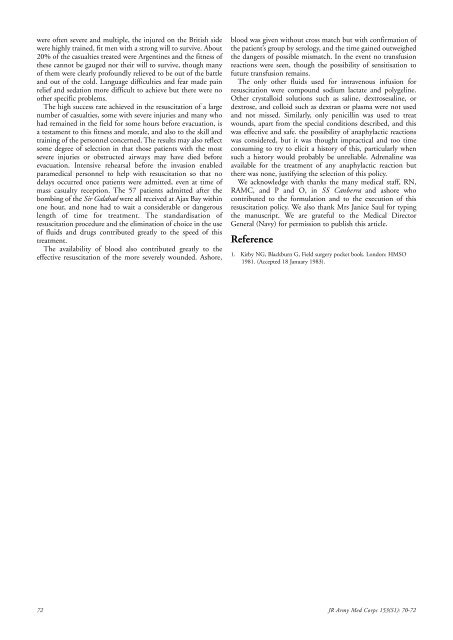Falklands war 25TH anniversarY - Boekje Pienter
Falklands war 25TH anniversarY - Boekje Pienter
Falklands war 25TH anniversarY - Boekje Pienter
Create successful ePaper yourself
Turn your PDF publications into a flip-book with our unique Google optimized e-Paper software.
were often severe and multiple, the injured on the British side<br />
were highly trained, fit men with a strong will to survive. About<br />
20% of the casualties treated were Argentines and the fitness of<br />
these cannot be gauged nor their will to survive, though many<br />
of them were clearly profoundly relieved to be out of the battle<br />
and out of the cold. Language difficulties and fear made pain<br />
relief and sedation more difficult to achieve but there were no<br />
other specific problems.<br />
The high success rate achieved in the resuscitation of a large<br />
number of casualties, some with severe injuries and many who<br />
had remained in the field for some hours before evacuation, is<br />
a testament to this fitness and morale, and also to the skill and<br />
training of the personnel concerned. The results may also reflect<br />
some degree of selection in that those patients with the most<br />
severe injuries or obstructed airways may have died before<br />
evacuation. Intensive rehearsal before the invasion enabled<br />
paramedical personnel to help with resuscitation so that no<br />
delays occurred once patients were admitted, even at time of<br />
mass casualty reception. The 57 patients admitted after the<br />
bombing of the Sir Galahad were all received at Ajax Bay within<br />
one hour, and none had to wait a considerable or dangerous<br />
length of time for treatment. The standardisation of<br />
resuscitation procedure and the elimination of choice in the use<br />
of fluids and drugs contributed greatly to the speed of this<br />
treatment.<br />
The availability of blood also contributed greatly to the<br />
effective resuscitation of the more severely wounded. Ashore,<br />
blood was given without cross match but with confirmation of<br />
the patient’s group by serology, and the time gained outweighed<br />
the dangers of possible mismatch. In the event no transfusion<br />
reactions were seen, though the possibility of sensitisation to<br />
future transfusion remains.<br />
The only other fluids used for intravenous infusion for<br />
resuscitation were compound sodium lactate and polygeline.<br />
Other crystalloid solutions such as saline, dextrosesaline, or<br />
dextrose, and colloid such as dextran or plasma were not used<br />
and not missed. Similarly, only penicillin was used to treat<br />
wounds, apart from the special conditions described, and this<br />
was effective and safe. the possibility of anaphylactic reactions<br />
was considered, but it was thought impractical and too time<br />
consuming to try to elicit a history of this, particularly when<br />
such a history would probably be unreliable. Adrenaline was<br />
available for the treatment of any anaphylactic reaction but<br />
there was none, justifying the selection of this policy.<br />
We acknowledge with thanks the many medical staff, RN,<br />
RAMC, and P and O, in SS Canberra and ashore who<br />
contributed to the formulation and to the execution of this<br />
resuscitation policy. We also thank Mrs Janice Saul for typing<br />
the manuscript. We are grateful to the Medical Director<br />
General (Navy) for permission to publish this article.<br />
Reference<br />
1. Kirby NG, Blackburn G, Field surgery pocket book. London: HMSO<br />
1981. (Accepted 18 January 1983).<br />
72 JR Army Med Corps 153(S1): 70-72

















